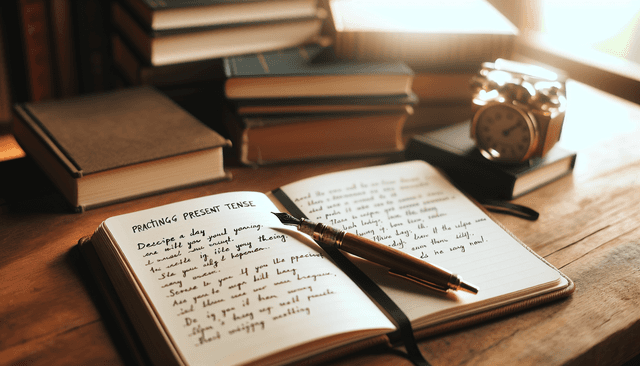Table of Contents
Struggling with writing in present tense can feel a bit like trying to catch smoke with your bare hands. You might wonder why it even matters or how to get it right without tripping over your own sentences. It’s common to feel a bit lost when juggling different tenses!
But don’t worry! If you stick with me, you’ll be armed with everything you need to master present tense writing. By the end, you’ll know how to choose the right tense and avoid those pesky mistakes that can sneak in.
We’ll break it down step by step, covering the different types of present tense, key rules, common pitfalls to sidestep, and even tips for practice. Let’s get started on this journey together!
Key Takeaways
- Writing in present tense makes your text feel immediate and engaging.
- Present tense includes forms like simple present, present continuous, present perfect, and present perfect continuous.
- Subject-verb agreement is crucial; make sure singular subjects have singular verbs and plural subjects have plural verbs.
- Practice conjugating both regular and irregular verbs to improve clarity in your writing.
- Choose the right present tense based on the context of your writing to communicate your message effectively.
- Maintain consistency in tense throughout your writing to avoid confusing your readers.

1. How to Write in Present Tense: A Step-by-Step Guide
Writing in the present tense can bring your text to life and create a sense of immediacy for the reader. This guide will help you navigate the nuances of present tense usage, making your writing clearer and more engaging.
1.1. Understanding Present Tense
So, what is present tense? Simply put, present tense describes actions that are currently happening or general truths. It’s crucial in writing because it keeps the reader grounded in the here and now.
The importance of present tense in writing cannot be understated. It allows readers to feel part of the action as if they are experiencing it along with the characters or the narrator. Plus, it can make your prose feel more dynamic and less static.
1.2. Types of Present Tense
Present tense isn’t just a one-size-fits-all hat; it comes in several varieties. Understanding these different forms can elevate your writing and help you choose the right one for your message.
1.2.1. Simple Present
The simple present tense is used for regular actions or universal truths. Think of it as your go-to for statements like “She walks to school” or “Water boils at 100 degrees Celsius.” It’s straightforward and clear.
This tense is particularly effective for providing information, creating rules, or expressing habits. Remember, it often employs the base form of the verb, possibly with an “s” added for any third-person singular subjects.
1.2.2. Present Continuous
The present continuous, also known as the present progressive, conveys actions that are happening right now. You would say, “I am writing this article,” rather than “I write this article.” The formation relies on the verb “to be” plus the verb ending in “-ing.”
This tense is great for adding a sense of immediacy or drama to your writing, especially when characters are experiencing events in real-time.
1.2.3. Present Perfect
When actions have started in the past and continue into the present or have effects in the present, we turn to the present perfect tense. You might say, “I have lived here for five years,” indicating your current residency status.
This tense uses “have” or “has” followed by the past participle of your verb. It’s perfect for showing connections between past actions and present situations, making it a valuable tool in narratives and essays.
1.2.4. Present Perfect Continuous
The present perfect continuous tense dives deeper into actions that started in the past but are still ongoing or have recently stopped, often emphasizing the action’s duration. For instance, “I have been studying for three hours” illustrates ongoing effort.
This form combines “have been” plus the “-ing” form of the verb and is excellent for stressing the length of an activity or the effort put into it.

2. Key Rules for Writing in Present Tense
Writing in the present tense can be tricky, but knowing the key rules can make it a whole lot easier.
These rules guide you in crafting clear and effective sentences that resonate with your readers.
2.1. Subject-Verb Agreement
Subject-verb agreement is a cornerstone of good grammar, and it’s especially important when writing in the present tense.
The basic idea is that your subject and verb must agree in number—singular subjects take singular verbs, while plural subjects take plural verbs.
For example, in the sentence “The dog barks,” “dog” is singular, so we use “barks.” Conversely, “The dogs bark” correctly uses the plural verb “bark.”
You should also be aware of tricky subjects, like collective nouns, which can be singular or plural depending on context. For instance, “The team wins” vs. “The team are fighting among themselves.”
To ensure subject-verb agreement, always identify your subject first, then conjugate your verb accordingly. This quick check can save you a lot of editing headaches later!
2.2. Verb Conjugation
Conjugating verbs in the present tense is essential for making your writing clear and polished.
In the simple present, regular verbs typically follow a pattern: you add an “s” or “es” for third-person singular forms, as in “He runs” or “She watches.”
Irregular verbs don’t always follow the same rules, so it’s important to familiarize yourself with their unique forms.
For instance, the verb “to have” changes to “has” in the third-person singular, leading to “He has a car.”
If you’re unsure about a verb’s conjugation, don’t hesitate to consult a reliable resource like a grammar guide or online conjugation tool.
Regular practice with various verbs also helps reinforce your understanding of these conjugation patterns.
2.3. Common Irregular Verbs
Irregular verbs can feel like the bane of a writer’s existence, but they’re also a vital part of mastering present tense.
Unlike regular verbs, which follow a predictable pattern, irregular verbs can change their forms in unexpected ways.
Take the verb “to be,” for example. In the present tense, it can appear as “am,” “is,” or “are,” depending on the subject.
Another common irregular verb is “to go,” which becomes “goes” for third-person singular, as in “She goes to the gym.”
Make a list of the most frequently used irregular verbs, and practice using them in sentences. This simple exercise can greatly improve your fluency and confidence.
Don’t shy away from these irregular forms; the more you use them, the more natural they will become in your writing.
3. How to Choose the Right Present Tense
Choosing the right present tense can dramatically affect the tone and clarity of your writing.
To pick the best tense, consider your message and the context in which you’re writing.
3.1. Determining the Context of Your Writing
Your writing context plays a pivotal role in selecting the appropriate present tense.
If you’re narrating an ongoing story, the present continuous works best, while for factual statements, the simple present is ideal.
For example, “The sun rises in the east” is a factual statement best expressed in the simple present.
Conversely, when describing a character’s actions in a story, you might say, “He is walking down the street,” to convey immediacy and engagement.
Before you start to write, ask yourself what you want to convey and choose the present tense that aligns with that intention.
3.2. Maintaining Consistency in Tense
Consistency in tense is key to coherent writing and helps maintain your reader’s focus.
Switching tenses can confuse your audience and muddle your message.
As you write, periodically check that you’re sticking to your chosen tense. If you start with the simple present, keep it consistent throughout that section.
For instance, don’t suddenly shift to present continuous mid-paragraph without a good reason—it can throw your reader off.
A good practice is to delineate sections of your text based on each tense being used. This way, readers can follow your thoughts without getting lost in a tense jumble.
If you find the urge to shift tenses, take a moment to think about whether it adds value to your writing or if it would be better left unchanged.

4. Tips for Practicing Present Tense Writing
Practicing your present tense writing skills can be both fun and challenging.
As you explore different techniques, you’ll become more comfortable and confident in using present tense effectively.
4.1. Writing Prompts for Present Tense
Using writing prompts specifically designed for the present tense can spark your creativity.
Try a prompt like, “Describe a day in your life as if it’s happening right now.”
This encourages you to immerse yourself in the present tense and capture details as they occur.
Another effective prompt is, “Write a scene where a character makes a crucial decision.”
This will help you practice describing immediate actions and thoughts consistently in the present tense.
4.2. Reading Examples in Present Tense
Reading examples of present tense writing can be incredibly valuable.
Look for novels or short stories written in present tense, such as “The Hunger Games” by Suzanne Collins.
As you read, pay attention to how the author uses different present tense forms.
Annotate your thoughts and note how the tense affects the narrative.
This active reading strategy will deepen your understanding and help you apply similar techniques in your writing.
4.3. Exercises for Improvement
Engaging in targeted exercises can bolster your present tense writing skills.
One exercise is to take a paragraph written in past tense and rewrite it in the present tense.
This forces you to rethink verbs and structure while honing your skills.
You can also create a daily journal where you strictly write in present tense about your experiences, thoughts, or observations.
This practice builds familiarity and fluidity, making present tense usage more second nature.
5. Common Mistakes to Avoid When Writing in Present Tense
Even seasoned writers can stumble over common pitfalls while using the present tense.
Avoiding these mistakes can improve the fluency and clarity of your writing.
5.1. Mixing Tenses
One of the biggest mistakes is mixing tenses, which can confuse your reader.
Stay vigilant in your writing; if you start in the present tense, stay there throughout your piece.
For example, if you write, “She walks the dog every morning and then played fetch,” the abrupt tense change disrupts the flow.
Instead, you’d say, “She walks the dog every morning and then plays fetch” to maintain consistency.
5.2. Misusing Irregular Verbs
Irregular verbs can trip you up if you’re not cautious, especially in the present tense.
For example, confusing “He go to school” instead of “He goes to school” can weaken your writing.
To avoid this issue, create a list of common irregular verbs and practice them in context.
Familiarity with these verbs will help you write confidently and reduce errors.
5.3. Overusing Present Continuous
While the present continuous tense is useful, overuse can lead to dull writing.
If every sentence describes actions using “is/are + verb-ing,” your writing may lack variety.
For example, “I am reading, I am writing, and I am thinking,” feels repetitive.
Instead, mix in simple present or present perfect tenses to create a more dynamic style.
6. Applications of Present Tense in Different Writing Styles
The present tense plays a unique role across various writing styles, each emphasizing different aspects of storytelling and information.
6.1. Creative Writing
In creative writing, the present tense can create an immersive experience for readers.
Think about how immediacy heightens tension in a thrilling narrative.
For example, “The wind howls as she runs through the dark woods,” instantly places the reader in the scene.
Experiment with first-person narratives and vivid descriptions to maximize the impact of your writing.
6.2. Academic Writing
When crafting academic papers, present tense is often employed to express facts and analyze current theories.
For instance, writing, “This study explores the effects of…” firmly establishes your analysis in the present.
Using present tense in research helps core concepts feel relevant and timely, drawing readers into the discussion.
6.3. Business Writing
In business writing, clear communication is key, and present tense provides that clarity.
When drafting reports, proposals, or emails, using present tense instills directness.
Instead of saying “The report indicated that,” try “The report indicates that.” It’s straightforward and effective.
7. Resources for Further Learning
If you want to deepen your understanding of present tense, several resources can help.
Exploring these materials can enhance your writing skills and confidence.
7.1. Books on Grammar and Tense Usage
Books on grammar specifically addressing present tense can be your best friends.
Titles like “The Elements of Style” by Strunk and White offer timeless advice.
They provide straightforward rules and examples to refine your writing style.
Seek out additional grammar handbooks that target specific tense usage for a more focused approach.
7.2. Online Writing Courses
Online writing courses are a treasure trove of knowledge.
Platforms like Coursera and Udemy offer courses targeting grammar and tense usage.
These structured lessons often include practice exercises and quizzes to reinforce your learning.
7.3. Writing Communities and Forums
Joining writing communities can offer valuable support and feedback.
Websites like Wattpad and Scribophile connect you with fellow writers who can critique your present tense usage.
Engaging in discussions can also expose you to different styles and perspectives on present tense writing.
FAQs
The different types of present tense include Simple Present, Present Continuous, Present Perfect, and Present Perfect Continuous. Each serves a unique purpose in expressing actions and states occurring in the present time.
To avoid common mistakes, ensure you maintain consistency in tense, correctly conjugate verbs, and be mindful of mixing tenses. Regular practice and reviewing grammatical rules can significantly help.
The present perfect tense is used to describe actions that occurred at an unspecified time in the past or that started in the past and continue to the present. It connects past events with present circumstances.
Useful resources for learning about present tense writing include grammar books, online writing courses, and writing communities or forums where you can seek advice and feedback from experienced writers.



